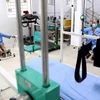The Health Environment Management Agency (HEMA), under the Ministry of Health, held a conference in collaboration with the World Health Organisation (WHO) to discuss the prevention of asbestos-related diseases on February 25 in Hanoi.
Asbestos is one of the elements in the inorganic toxic dust workers are exposed to in the manufacturing process, according to the WHO and the International Agency for Research on Cancer (IARC).
It causes respiratory problems, silicosis disease, pleural thickening and cancer.
WHO policy has encouraged countries to gradually eliminate asbestos and use substitutes. As a result, over 40 countries worldwide have put asbestos on the list of banned substances for use or trade, such as Japan, Sweden and Finland.
Vietnam is one of ten countries in the world using the largest amount of asbestos, with 11,000 employees at a high risk of developing asbestos-related diseases.
The prevention of occupational diseases related to asbestos has been difficult due to its long incubation period, up to 20-30 years, as well as lack of labour awareness on its harmful effects, and the regulations on labour safety and hygiene in many workplaces.
The ministry has completed a draft on guiding diagnostic criteria and cancers related to asbestos to supplement to the list of occupational diseases receiving insurance.
It has continued to improve the capacity of the health sector on monitoring working environments and managing the health of workers exposed to asbestos, as well as proposing a ban on the use of dangerous substances in the Draft Law of Environmental Protection.-VNA
Asbestos is one of the elements in the inorganic toxic dust workers are exposed to in the manufacturing process, according to the WHO and the International Agency for Research on Cancer (IARC).
It causes respiratory problems, silicosis disease, pleural thickening and cancer.
WHO policy has encouraged countries to gradually eliminate asbestos and use substitutes. As a result, over 40 countries worldwide have put asbestos on the list of banned substances for use or trade, such as Japan, Sweden and Finland.
Vietnam is one of ten countries in the world using the largest amount of asbestos, with 11,000 employees at a high risk of developing asbestos-related diseases.
The prevention of occupational diseases related to asbestos has been difficult due to its long incubation period, up to 20-30 years, as well as lack of labour awareness on its harmful effects, and the regulations on labour safety and hygiene in many workplaces.
The ministry has completed a draft on guiding diagnostic criteria and cancers related to asbestos to supplement to the list of occupational diseases receiving insurance.
It has continued to improve the capacity of the health sector on monitoring working environments and managing the health of workers exposed to asbestos, as well as proposing a ban on the use of dangerous substances in the Draft Law of Environmental Protection.-VNA



















